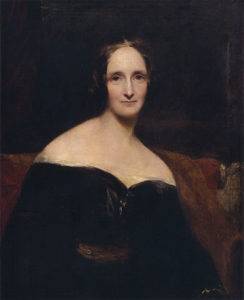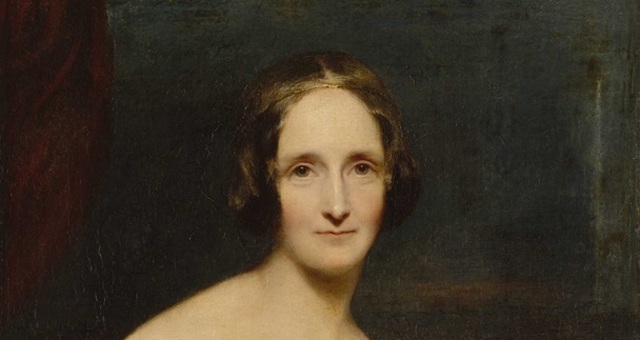
Mary Shelley, author of the classic horror novel Frankenstein, is a goth icon. She wrote about the horrors of mankind, painted the grimmest of settings in her writing, and lived a life full of mystery and tragedy. While some may simply know her as the woman who wrote Frankenstein, there’s more to her story. Here are some fun facts about Mary Shelley that you might not know!
8 Fun facts About Frankenstein’s Author, Mary Shelley
1. Mary Shelley published Frankenstein in 1818 when she was just 21 years old.
In fact, Mary Shelley wrote her most iconic piece of literature when she was just 18 years old! When the novel was first published, there were many reviews bashing the premise of the story with one review by John Wilson Croker, in 1818, stating that the novel “inculcates no lesson of conduct, manners, or morality; it cannot mend, and will not even amuse its readers, unless their taste have been deplorably vitiated…”
But, despite being critiqued by some reviewers, at the time, Frankenstein became a hit among readers who loved the gothic tale that quickly became a classic piece of literature.
2. Mary Shelley was inspired to write Frankenstein for a ghost story challenge during “the year without summer.”
During the summer of 1816, the weather was abysmal and Percey Shelley and Mary Godwin (at the time) traveled to Geneva, Switzerland for the season. There, Percy, Mary, their son, William, and Mary’s stepsister, Claire, happened upon Lord Bryon, who was traveling with John Polidori, his physician at the time. According to the British Library, they spent dark and gloomy summer days together discussing personal philosophies and how life is created.
Then, one day, Lord Bryon suggested that they all write ghost stories to share with one another. In the author’s introduction of Frankenstein, Mary Shelley wrote,
“I busied myself to think of a story…One which would speak to the mysterious fears of our nature and awaken thrilling horror—one to make the reader dread to look round, to curdle the blood, and quicken the beatings of the heart. If I did not accomplish these things, my ghost story would be unworthy of its name.”
Through the influence of the ghost story competition and the somber setting of their summer, Mary Shelley was inspired to create her most iconic horror story that would be retold generations later.
3. Mary Shelley’s inspiration for Frankenstein came from a nightmare.
Stuck together with nothing to do other than reading poetry and musing ideas with one another in their summer villa, Mary Shelley had a nightmare during one dreary night. She wrote in her author’s introduction that she dreamed of what would become Victor Frankenstein, “He sleeps; but he is awakened; he opens his eyes; behold, the horrid thing stands at his bedside, opening his curtains and looking on him with yellow, watery, but speculative eyes.”
Once she awoke, Mary Shelley felt compelled to write more of this story by telling her readers, “I have found it! What terrified me will terrify others; and I need only describe the spectre which had haunted my midnight pillow.”
4. Frankenstein is considered one of the first early examples of science fiction.
After Frankenstein was published and readers began flocking to read the gothic horror novel centered around a scientist who creates new life through the use of galvanism, people throughout history have considered Mary Shelley to be the creator of science fiction.
According to the Oxford Dictionary of National Biography, Frankenstein is “the best-known fiction of the Romantic era” and is one of the earliest examples of science fiction in the history of storytelling, a topic that is up for debate by many readers throughout centuries.
5. Mary Shelley originally published Frankenstein anonymously.
When Frankenstein was first published, Mary Shelley did not attach her name to the story, and so the novel was considered anonymously written. Because of this, readers began to wonder if Percy Shelley had actually penned Frankenstein because he wrote the introduction to the story, according to Biography.
The Seattle Times reported that Frankenstein was actually republished twice: once in 1823 when Mary Shelley was finally attributed as the author of the work, and another time in 1831. The most horrific thing of all? “Mary Shelley never earned royalties from [Frankenstein].”
6. It’s rumored that Mary Shelley kept the calcified heart of Percy Shelley.
One of the more gothic facts about the creator of Frankenstein is that, when her husband died by drowning at a young age, his body was cremated, but one thing stayed put. His heart which had calcified and refused to burn, stated The New York Times. So, like the goth queen Mary Shelley is, she kept her late husband’s heart with her at all times until her passing where it was found on her writing desk beside her last work in progress, said Mental Floss.
If that isn’t the most goth thing you’ve read, then I don’t know what will be.
7. Mary Shelley’s mother was a feminist, which influenced her writing.
While Mary Shelley was not able to get to know her mother, Mary Wollstonecraft, who died postpartum, it is important to note the great influence her mother had. Mary Wollstonecraft was a writer, advocate for women’s rights, and a philosopher who wrote A Vindication of the Rights of Woman calling for women to get a fair education in order to rise in society.
While these two influential women—in their own right—may not have been able to share a life together, it’s clear that Mary Shelley came from an intellectual family unafraid of breaking down the boundaries of society. This may have influenced her to write Frankenstein at a time when women were shamed for writing about the darker sides of life.
8. Mary Shelley wrote more than just Frankenstein.
While she is known for penning the infamous Frankenstein, Mary Shelley wrote more novels throughout her career that readers may not know about. In 1823, Mary Shelley published Valperga, a historical fiction novel following Castruccio Castracani, who invades a fictitious land run by Euthanasia. Throughout the story, Castruccio makes Euthanasia choose between her love for him or her love for her land, Valperga, a storyline much different from that of Frankenstein.
She also wrote The Last Man in 1826, an apocalyptic science fiction novel exploring a world that is doomed with a plague wiping the population. Another novel she wrote was Lodore in 1835, a novel centered around women’s roles in society and in families, which is much different from her other works.
So, those are some fun facts about Mary Shelley, our goth queen of writing. Have you read any of Mary Shelley’s works, and if so, which are your favorites?
By signing up you agree to our Terms of Service

